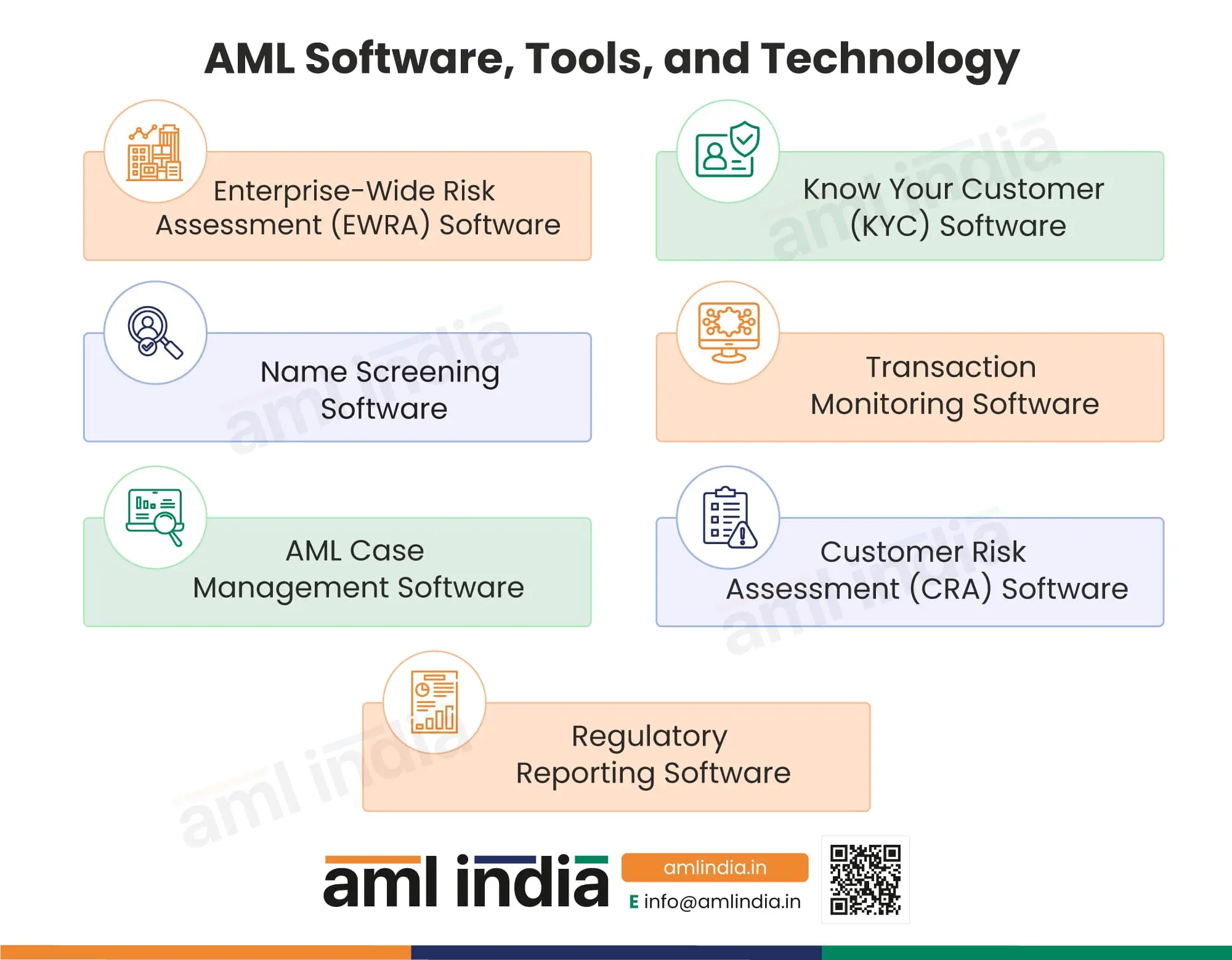
Contact details
Phone No: +91 98248 84900
Email Id: info@amlindia.in
AML Software, Tools, and Technology
AML Software, Tools, and Technology
Anti Money Laundering (AML) software, tools, and technology are solutions that aid Reporting Entities regulated under the Prevention of Money Laundering Act 2002 in detecting and mitigating financial crime risks while ensuring they meet their compliance requirements easily. In the present infographic, we have discussed the various types of software available that can be adopted by Reporting Entities to optimise their AML/CFT/CPF program. The types of AML software, tools, and technologies are as follows:
Enterprise-Wide Risk Assessment (EWRA) Software
An Enterprise-Wide Risk Assessment (EWRA) helps a Reporting Entity identify and assess the overall Money Laundering (ML), Terrorism Financing (TF), and Proliferation Financing (PF) risks that it is exposed to in order to adopt the most suitable risk control measures.
An EWRA software optimises and accelerates this process by collating and aggregating data from various sources and calculating the likelihood and impact of a risk factor, as well as other required assessments automatically. This process allows businesses to prioritise high ML/TF/PF risk areas and implement necessary mitigation measures.
Know Your Customer (KYC) Software
KYC is the process of identifying a customer and verifying their identity using authentic sources. KYC prevents Reporting Entities from engaging with customers involved in financial crimes by detecting potential ML/TF/PF risks emanating from them.
A KYC software automates this process by providing functionalities such as liveness checks, biometric verification, document authentication, information storage and organisation, simplified KYC questionnaires, checklists and forms with auto-filling and pre-filling, document upload and retention, document expiry alerts, e-KYC, self-KYC, re-KYC, ongoing monitoring, video KYC, etc. KYC software provides advantages such as reducing manual errors, allowing Reporting entities to onboard clients virtually, enhancing customer experience, etc.
Name Screening Software
Name screening software enables Reporting Entities to screen their customers against Sanctions, Politically Exposed Persons (PEP), and Adverse Media watchlists. Sanctions screening helps Reporting Entities promptly detect sanctioned persons and report them as required under India’s AML/CFT/CPF regulations. PEP and Adverse Media screening aid Reporting Persons to assess the ML/TF/PF risks emanating from their customers and make informed decisions on risk management and control.
A name screening software has features such as access to an extensive library of global Sanctions, PEP, and Adverse Media watchlists, fuzzy matching, whitelisting, machine learning, advanced matching algorithms, easy disambiguation, etc.
Transaction Monitoring Software
Reporting suspicious transactions that indicate the occurrence of ML/TF/PF is mandatory for Reporting Entities. A transaction monitoring software analyses vast amounts of customer and transaction data on a real-time basis, based on set parameters, to detect any suspicious transactions. This software alerts businesses to potential risks, ensuring that quick action can be taken to prevent financial crimes.
AML Case Management Software
AML case management software helps in the efficient management of customer lifecycle and AML related tasks. It allows effective collaboration between different staff and roles of the Reporting Entity working on AML compliance. It streamlines AML processes through customisable workflows, standardising them across the organisational structure of the reporting entity. It allows the Reporting Entity to gain an overview of all AML tasks related to a customer on a single dashboard. It also helps maintain a complete audit trail for transparency and accountability.
Customer Risk Assessment (CRA) Software
Customer Risk Assessment (CRA) helps Reporting Entities assess and evaluate the ML/TF/PF risks associated with a customer and adopt risk control measures accordingly. CRA software helps in CRA by aggregating data from multiple sources and calculating a customer’s risk score based on set risk factors and risk weightage.
CRA software also supports ongoing risk management by continuously monitoring customers and updating their risk profiles as new information becomes available. This ensures that businesses maintain an accurate and up-to-date understanding of customer risks, enabling them to comply with AML regulations efficiently and reduce exposure to financial crimes.
Regulatory Reporting Software
Under the Prevention of Money Laundering Act 2002, its corresponding rules, and other AML/CFT/CPF laws of India, Reporting Entities are required to submit regulatory reports to the Financial Intelligence Unit of India such as Suspicious Transaction Reporting (STR), Cash Transaction Report (CTR), etc. Regulatory reporting software helps gather information, conduct internal investigations, review the report, seek the AML principal officer and Senior Management’s approval, etc.
AML Software, Tools, and Technology: Final Thoughts
The software tools discussed in this infographic help Reporting Entities streamline and strengthen their AML processes by automating AML tasks, reducing manual errors, and helping achieve AML excellence. However, reporting entities must be careful when selecting AML software. The selected software must fit their unique requirements and be tailored to their needs.
Important Links
subscribe to newsletter



